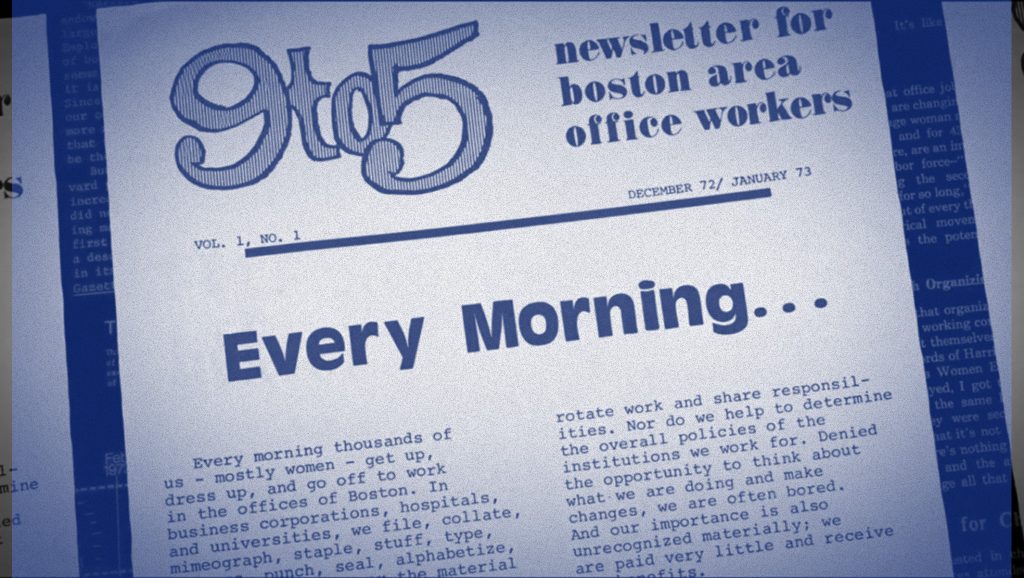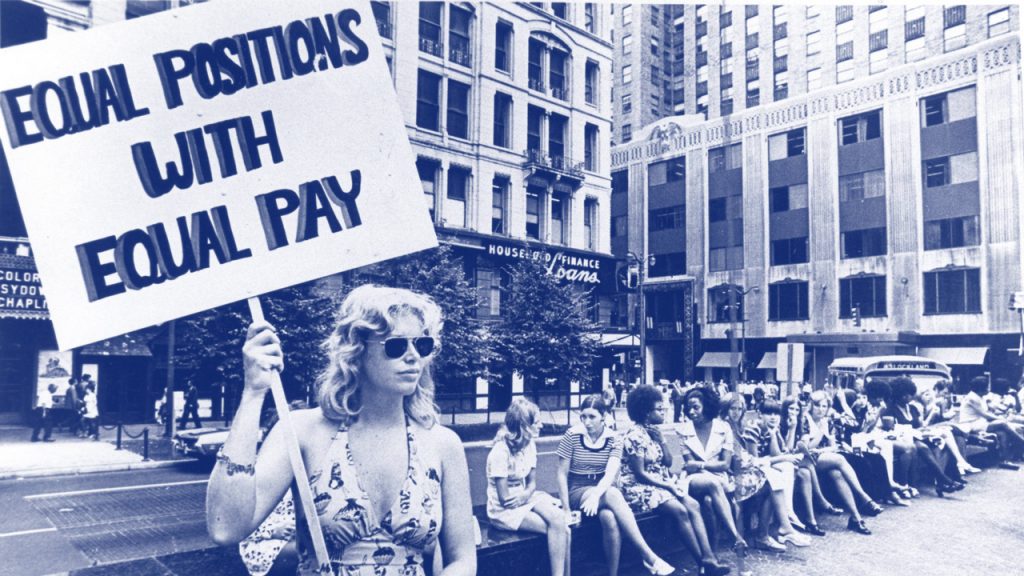9to5: The National Association of Working Women
By Debra Bergen and Eric Dirnbach
9to5 is the organizing campaign for women office workers that started in Boston in 1972. It responded to the wave of women joining the workforce in the 1960s and 1970s, many into secretarial jobs under conditions of gender discrimination and sexual harassment.
This campaign can be understood in a number of ways. It was an industry worker association and a part of the working-class feminist movement focused on wages and working conditions, including the prevalence of sexual harassment in the workplace. It was also a kind of pre-majority campaign in that it organized a relatively small number of workers at many employers in various sectors to improve overall conditions. It eventually affiliated with SEIU and ran traditional union campaigns in some workplaces involving NLRB union elections. The campaign inspired the popular 1980 film and song.
Formation and Strategy
9to5 was founded by Karen Nussbaum and Ellen Cassedy, both office workers at Harvard University. They started a local newsletter titled “9to5: Newsletter for Boston Area Office Workers” in 1972 and used it to organize women office workers, officially launching the 9to5 association the next year.
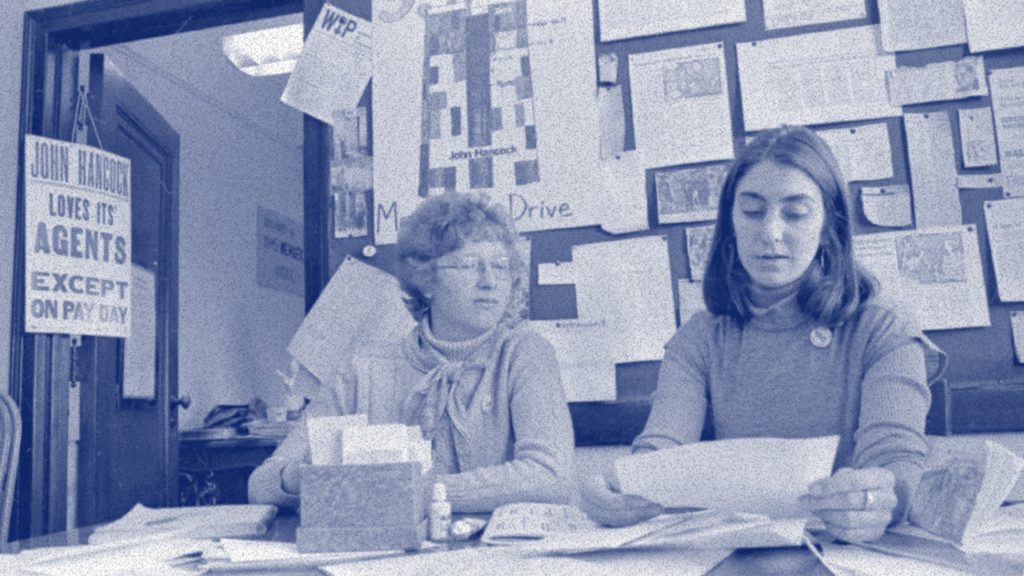
Cassedy discusses in Teen Vogue how women workers encountered the workplace in that era.
“It was at this point that millions of women began pouring into the workplace, many of them into what became known as the “pink-collar ghetto” — low-wage jobs with little mobility. Influenced by the Civil Rights and feminist movements, they wanted rights and they wanted respect. In the newly configured economy, one in three working women was an office employee. As the clerical workforce grew by leaps and bounds, so did a sense of injustice among the women whose job it was to type, file, staple, mimeograph, and photocopy. Women office workers were tired of low pay, discrimination, and training men to be their supervisors. A half-century before the #MeToo movement, they wanted an end to sexual harassment and the whole host of petty indignities they were subjected to. As one woman put it, “We are referred to as ‘girls’ until the day we are retired without pension[s].””
Ellen Cassedy
9to5 sent Cassedy to attend the new Midwest Academy organizer training school in Chicago to help figure out the group’s strategy. Cassedy recounts some of the training in her new book, “Working 9 to 5.” According to Cassedy, one of the instructors noted that,
“…9 to 5 [had been] operating on the ‘rock pile theory’…and that would never get us anywhere. The point was not to get people into a meeting room one by one—to pile them up and keep them there until it was time to figure out how to move forward. Instead, we should start by doing something—something effective. When people heard about it, they’d come flocking, eager to join in.”
Ellen Cassedy
Cassedy took back the Midwest Academy theory of change that 9to5 would use effectively to
- Win reforms that improve people’s daily lives
- Make sure that when people win reforms, they see those gains as rights they’ve achieved through their own collective power
- Alter existing relations of power, weaken the domination of the few, and strengthen the hand of the many
An early action occurred when 9to5 discovered that large employers in Boston illegally colluded to keep women’s clerical wages low, through an association called the Boston Survey Group. Through demonstrations and picketing, and filing an antitrust complaint, they put an end to that collusion and won a 10% wage increase. 9to5 also filed discrimination lawsuits against major Boston publishing companies that were paying women significantly less than men, settling for $1.5 million in back pay, and better employment policies.
The campaign organized in non-traditional ways, with plenty of humor, funny songs, skits about sexist bosses, and bad boss contests to help change the idea of what was acceptable boss behavior. 9to5 held organizing lunches, surveyed women workers, published reports, held public hearings, and drew up a Bill of Rights for Women Office Workers. That Bill listed demands such as “clearly defined and written job descriptions, compensation for overtime work, regular salary reviews, maternity benefits, on-the-job training programs, and benefits equal to those of men.”
9to5 campaigned for affirmative action plans and more effective enforcement. It picketed on National Secretaries Day demanding “Raises Not Roses.” The campaigns to pressure major companies such as John Hancock Insurance and First National Bank to raise wages were often successful.
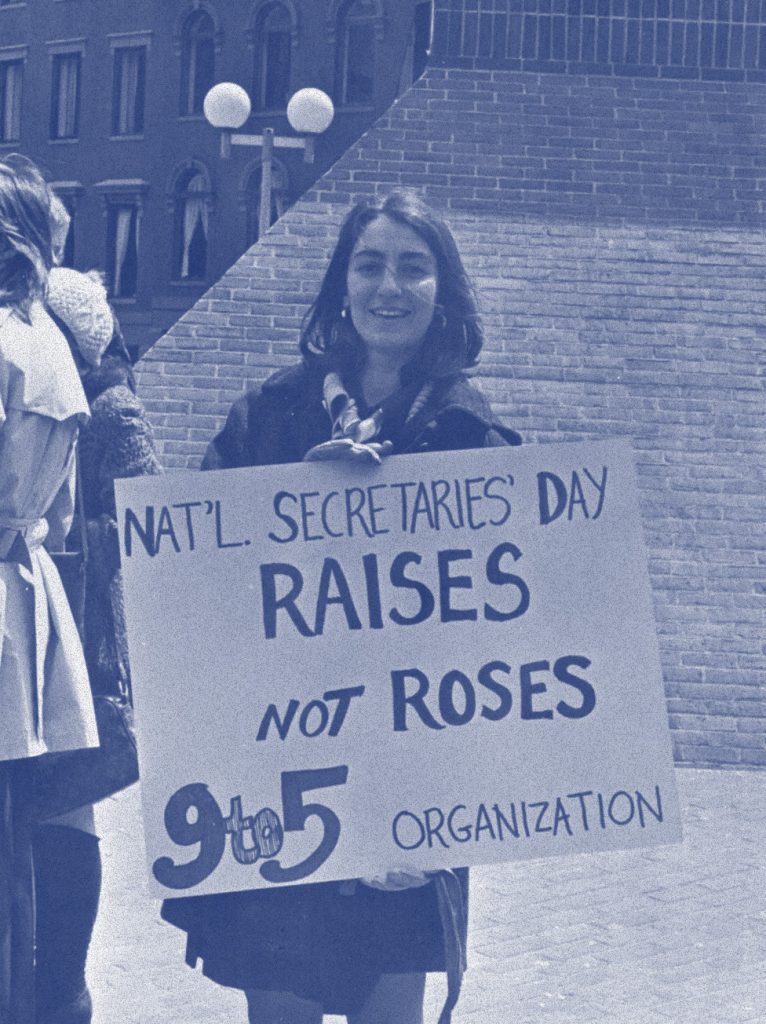
9to5 spread to other cities, as it organized against the unfair conditions it discovered. An example is the protest against unequal pay at National City Bank in Cleveland, Ohio. They found that male bank staff were paid 50% more than women, in violation of federal anti-discrimination laws. Because the bank handled federal money, 9to5 was able to push the Office of Federal Contract Compliance Programs to take action. All of this organizing was outside of traditional collective bargaining.
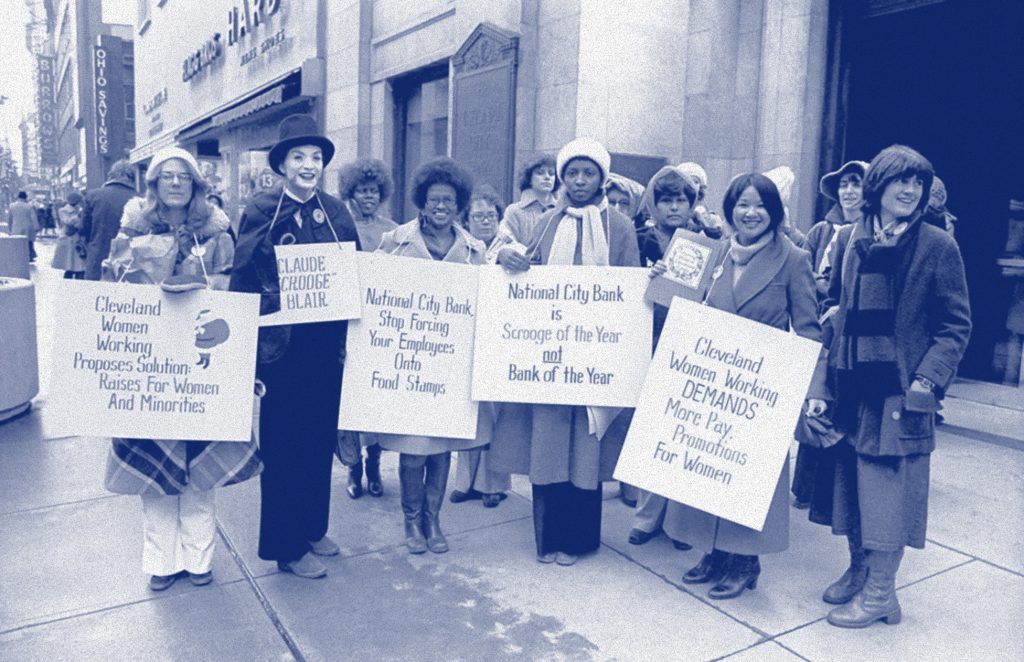
Partnering with Traditional Labor
Cassedy recounts how 9to5 encountered sexism from some male labor leaders of that era. But in 1975, 9to5 teamed up with a respectful partner, the Service Employees International Union (SEIU), to form Local 925 and do more traditional union organizing and collective bargaining with women workers. In 1981, they received a charter from SEIU to organize as District 925. See the brochure from District 925.
These campaigns spread to other cities including Cincinnati, Detroit, Pittsburgh, San Francisco, Los Angeles, Hartford, New York, Seattle, and Atlanta. There were successful union elections and contract victories, but 9to5 ran up against the same union busting strategies that were becoming more common, especially in the private sector in the 1980s.
In an interview, 9to5 co-founder Nussbaum talks about the dual nature of the group as bridging the women’s and labor movements:
“On the one hand, we were building a wing of the women’s movement that was for working women, who didn’t otherwise identify with the women’s movement. This was a way to expand the women’s movement to a new group of women who otherwise weren’t getting there. On the other hand, we were bringing the women’s movement into the labor movement. So we were operating to create a home for working women in the women’s movement, and for women in the labor movement.”
Karen Nussbaum
9to5’s dual structure as a worker association and a union meant that it was using a variety of organizing strategies. Labor historian Lane Windham summarizes the success of 9to5’s unique approach in “Knocking on Labor’s Door: Union Organizing in the 1970s and the Roots of a New Economic Divide.”
”The union, SEIU Local 925, won a few NLRB elections, but it found that most of the private-sector employers it challenged were able to block workers’ organizing efforts by manipulating and breaking labor law. The association had more success…The 9to5 founders were essentially the foremothers of what today is known as ‘alt-labor,’ the wave of workers’ centers, associations, and campaigns that seek to build power for workers outside the collective bargaining paradigm in the early twenty-first century. For a time, these women labor activists were able to use the new organizing forms of the women’s movement, in combination with community organizing tactics, to build an entirely new doorway into economic security and greater equality for America’s workers.”
Lane Windham
9to5’s Impact and Legacy
9to5 ran into the tough conservative environment of the 1980s that confronted the entire labor movement. Today, businesses still exploit women workers through lower pay and other discriminatory tactics, particularly in low wage sectors. But 9to5 nevertheless played a crucial role in empowering women workers, raising the issues of gender discrimination and sexual harassment, and improving working conditions.
The 9to5 association still exists in several states, and SEIU has Local 925 in Seattle. A Netflix documentary about the movement was released in 2021.
Overall, 9to5 is a fascinating example of a major national campaign, led by women, that built a worker association to organize within secretarial occupations in a number of industries. It used diverse approaches, including both traditional NLRB union elections, and non-traditional pre-majority strategies including workplace actions and community organizing tactics.


